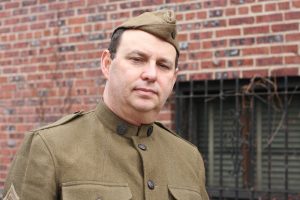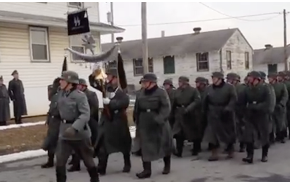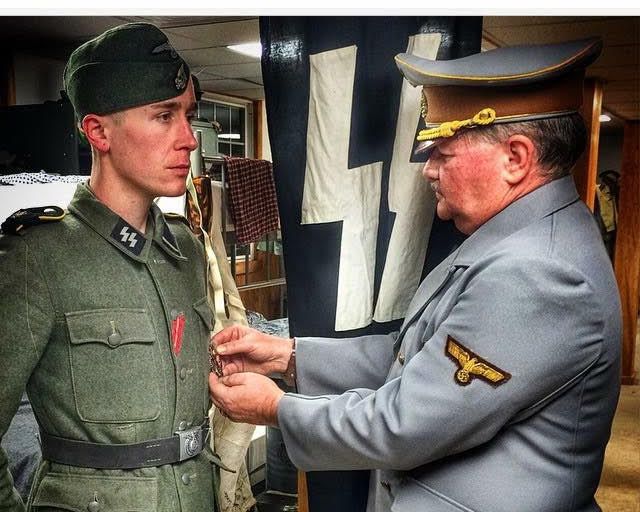Battle of the Bulge cancellation: ‘Reenactors have nobody to blame but themselves’
Reenactors in a barrack at Fort Indiantown Gap portray a Waffen-SS officer receiving a medal.
Last week, the World War II Historical Association voted to cancel its annual Battle of the Bulge reenactment. The event – which has been held at the military training base of Fort Indiantown Gap (FIG) for more than thirty years – met its demise after the Army set up stringent rules in the aftermath of an accident last winter which sent one reenactor to the hospital.
The cancellation set off a firestorm of controversy within the reenacting community after a statement about the decision was made public on social media by Association Chairman Larry Mihlon. In his statement, Mihlon noted that the Army would now require that reenactor leaders be trained in the fashion of officers in the U.S. Army.
Currently, reenactor officers have no real authority over the men and women in their command.
A second requirement is that all reenactors who take to the simulated battlefield be certified to U.S. Army standards in the use of WWII-era weaponry.
Mihlon also pointed out in the statement that, “Social media and other internet traffic relating to the event, which was seen by the Garrison, led to significant concerns. Social media has wide visibility and what was seen by Garrison personnel was cited as potentially creating a negative public perception of Fort Indiantown Gap.”
In an effort to hear all voices in this important matter, we spoke with Larry Mihlon and asked a series of follow-up questions. We also reached out to the Public Affairs Office at Fort Indiantown Gap; to other interested parties; and to members of the reenacting community.

Kevin C. Fitzpatrick is an occasional contributor to the Baltimore Post-Examiner. He is a respected author, historian and a highly regarded member of the military reenacting community. After his graduation from college in 1989, Kevin served two years regular duty as a journalist-photographer in the United States Marine Corps. We talked with Kevin, after receiving emails and troubling pictures from other members of the reenacting community.
BPE: Thank you for phoning us during what must certainly be your lunch hour.
KF: My pleasure. As you know, this is currently the biggest story in the reenacting community. Outside of Reading, PA, where they do the WWII Weekend, the Battle of the Bulge event is the biggest gathering of WWII reenactors on the East Coast. And the reason it is such a big event is it’s a field exercise, firing blanks. Plus you are sleeping in a barracks on an army post, and there is a big band dance as well. So, it brings both men and women to FIG, and now this huge event has been cancelled.
BPE: Was the Army right in instituting these new rules?
KF: I think the Army was well within its rights to cancel the event. That is, they set the rules which led to the cancellation. The reenactors brought this on themselves. There is nobody else to blame. They didn’t listen – they didn’t follow what the Army was saying. They went around and broke the rules that the army had set out.

Number one, by bringing things like dummy grenades and dummy land mines that got left behind. The army would find them in the field after the reenactors left. They would then have to call in their ordnance disposal team, which costs the Army money and cut into the field time for the National Guard units, who only have a very limited amount of time to train.
The other thing is, it looks really bad on social media when reenactors were openly flaunting the rules and regulations. Obviously, this got back to the Army and the National Guard.
BPE: When I was there in January with my photographer, everyone seemed pretty tight-lipped about the accident.
KF: Yes, well the reenactors were all over social media talking about it.
The crux of the issue is this: In the military, you have a chain of command and that chain is followed. Reenacting is a fake army. In reenacting, you may be a captain or a major, but you really have no authority over the people who are “under you” in your unit. If the captain says, “Don’t bring a dummy grenade,” you don’t have to listen to him, because there is no uniform code of military justice. So what the real army didn’t like is that, in the fake army, there are no consequences. There is no training. There is no command structure. Reenactors don’t salute each other. You’re on your own honor not to break the rules that the Army set up.
One of the things they laid out in their directives is that anyone who assumes these command positions submit to training. The Army can’t control the reenactors because the reenactors can’t control themselves. They did some really stupid things over the last few years. And this is all over social media, too. If you look around a little, you’ll find it there.
BPE: What about the photos which have surfaced of hijinks on the German side?

KF: I can understand the desire to represent the other side – to represent Germany. But don’t come dressed as Adolf Hitler. Don’t come dressed as the SS. That’s just ridiculous.
As a reenactor myself – I’ve been doing this a long time – I have total respect for people who want to portray the Axis or civilians on the German side. But you don’t want to do a reenactment in a public place, such as a U.S. Army fort, portraying stormtroopers or the Waffen-SS. Are you doing this for the living history part of it, or are you just a racist?
That’s what it really comes down to.
BPE: So, the perception is something they should really be concerned about?
KF: Yeah, and some of these reenactors want to reenact German camps with SS flags and things like that. You have to ask, “Why are they doing that kind of living history?” It’s a shame because the majority of the reenactors do want to follow the rules and do the living history. But there are a few bad apples who are spoiling it for everybody. And that’s a shame, too, because FIG was a longstanding event that a lot of people looked forward to.
BPE: Do you do both WWI and WWII reenacting?
KF: I do both, though I am not a FIG person, and this year, with the World War I Centennial, my focus has been on WWI events. But everyone I know from the metro area around New York goes to FIG. I talk with these guys most every weekend, so I’m just offering this as a reenactor and an event organizer.

My big upcoming event will be in September on government property. And I would never, ever want to violate the rules that the National Parks Service sets out. If you don’t listen to the Parks Service rules, you can’t come back again.
We have very definite rules for our events. If you are bringing a rifle, it has to be looked at to be sure there is no live ammunition. You wrote a story last winter about the worst accident to ever happen at FIG, but in Civil War reenacting, there have actually been people who were shot. That’s because people weren’t following the rules.
BPE: Could we go back for a minute to the educational aspects of reenacting and possibly touch on what has been lost with the cancellation of FIG?
KF: Sure. Before someone puts on a uniform, they have probably read a number of books. I mean, you really want to do your research into portraying a particular unit or person. Most real reenactors will boil it down to one specific man in one specific unit in one specific conflict. That’s what their historical impression is about. So you want to have everything related to him from the helmet to boots to be absolutely perfect. Then, when you provide that living history to the public, you are showing them a true living history. And it doesn’t matter if it’s the Revolution, War of 1812, the French and Indian War or the Civil War. You are imparting history to your audience, just as much as if they were in a museum or reading a good historical novel.

A good reenactor will be an expert at research and writing. To the point where you know the difference between a 1916 belt and one that was worn in 1918. People will critique on things like that, which will make you a better reenactor and living historian.
Another example is, if you are doing the Revolutionary War, you would never portray your character in a uniform that was done on a sewing machine. That has to be hand-sewn. It adds to the authenticity of the experience you are giving the public, because you want to look just like that guy you are portraying did back in 1777.
So, for me as a living historian, I want to be a really good representation of the person I exemplify.
Going back to FIG, it’s really too bad, because the group had a perfect location to reenact the Battle of the Bulge. That’s one of the most important events in our nation’s history. They were able to do an amazing military installation and get it pretty close to what it was like to be in France in the winter of 1944.
BPE: Is what has happened here with the cancellation of FIG a teaching moment for the overall reenacting community? If so, does it behoove reenactors to set aside some of these public events in favor of serious army-style training exercises?
KF: I think that’s a great idea. One of the reasons we are having our event in September is to get ready for the Veterans Day Parade in November. Our training is on marching and military appearance. The manual of arms: How do you carry a rifle? How do you stay in step? Because in November, we’re gonna be in a parade in front of a million people. So, you want to look really good. And you want to honor our military past by looking good. Unless you do that training a couple of times a year, you won’t look good. But again, if they did that training and tried to revive FIG, you’d still need that authority where someone can say to you, “Don’t bring those dummy hand grenades.” You have to have that respect for authority.
BPE: Does the training you know of for other reenactors go beyond how to carry a rifle?
KF: Training does take place for other kinds of reenacting. The New Jersey Field Music Group does rehearse. When they go out, they sound and look good. There’s a WWII Living History group out on Long Island that has actual tanks and armored personnel carriers. They train all the time, so that they don’t hurt themselves or the public. You’ve really got to be prepared to take it to the next level.
At the end of the day, it’s a hobby much like with people who go to Orioles games fifty times a year. People who are that ardent will spend thousands of dollars on tickets, clothing and accessories. But Oriole fans aren’t throwing baseballs.
This really gets down to the root of the hobby. Are you doing this to create a living history lesson for the public, or are you doing it because you want to go in the field with a bunch of guys and burn powder, and drink beer at night?
If it’s the latter, then you’re in the wrong kind of hobby.

Anthony C. Hayes is an actor, author, raconteur, rapscallion and bon vivant. A one-time newsboy for the Evening Sun and professional presence at the Washington Herald, Tony’s poetry, photography, humor, and prose have also been featured in Smile, Hon, You’re in Baltimore!, Destination Maryland, Magic Octopus Magazine, Los Angeles Post-Examiner, Voice of Baltimore, SmartCEO, Alvarez Fiction, and Tales of Blood and Roses. If you notice that his work has been purloined, please let him know. As the Good Book says, “Thou shalt not steal.”


You talked to a jackass who knows nothing about anything, comes from liberal New York and wants to compare German Reenactors to Racists. Your story is invalid and this jack wagon is a pompus dolt who I wouldn’t be caught dead on the field with and have been doing campaigner level reenacting and living history for years.
https://uploads.disquscdn.com/images/8123a7cf622cf5abd511e6e7b5ad819fc626991aaa4a08c462912538ccf840d3.jpg F U Kevin,
Interesting article, However using Kevin a source wasn’t the right thing to do. By his own admittance He isn’t a FIG person, He does not belong to to any WW2 units and pretty much just called everyone who does Waffen-SS “Racist”. This article was shared far and wide and condemned by pretty much all of the East Coast community. This article also called a very well respected (retired) member of an east coast group “Hitler”, although that was corrected a few hours later, The damage was already done.
Unfortunately Kevin’s name is now mud and will no doubt lead to being blacklisted from WW2 themed events.
Interesting article and comments. Not my time period, but the comment on camaraderie says it all. If you choose to be a talking mannequin with no other purpose, fine. Have at it. Some people may want to actually enjoy themselves beyond that. The root problem here…if we’re really honest.., is the lack of enforcing standards that SHOULD be written into organizational bylaws.
As the interviewee stated, this isn’t the “real Army,” but your organization IS liable for what they do or fail to do. So…a self inflicted wound to a degree.
You can accept the idea that different people in the hobby have different opinions on things. It doesn’t make you good or bad. One opinion does not an authority make. Methinks it is the only person the author knows.
Safety is an issue, and my organization has kept people off the field for lack of proper shoes, unserviceable weapons, and lack of competency at handling a musket. As a body of enthusiasts…you OWN it.
Reenactments are just stupid. Its mostly fat guys playing toy soldier.